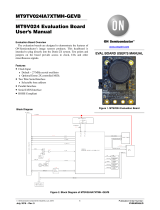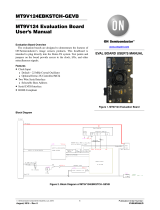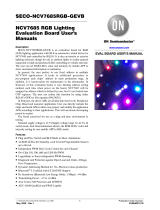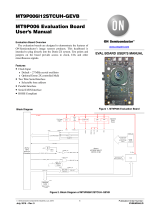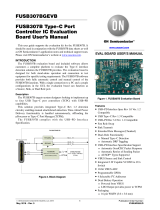Page is loading ...

© Semiconductor Components Industries, LLC, 2018
November, 2018 − Rev. 1 1Publication Order Number:
EVBUM2595/D
EVBUM2595/D
DVK-AXM0F243-xxx-x-GEVK
Evaluation Kit
User's Manual
Introduction
The DVK−AXM0F243−868−x−GEVK and
DVK−AXM0F243−915−x−GEVK kits are designed as quick start
solution for the development of applications with the AXM0F243 RF
System On Chip (SoC). This SoC combines an ARM Cortex M0+
ultra−low power microcontroller with the AX5043 ultra−low power
RF transceiver in a single IC package. The
DVK−AXM0F243−868−x−GEVK is optimized for 868 MHz
frequency, and the DVK−AXM0F243−915−x−GEVK development
kit is enhanced for 915 MHz. The
DVK−AXM0F243−xxx−x−GEVK’s are compatible with
AX−RadioLab and AxCode::Blocks development software for the PC.
Figure 1. DVK−AXM0F243−868−x−GEVK Kit
1
23
5
4
6
7
www.onsemi.com
EVAL BOARD USER’S MANUAL

EVBUM2595/D
www.onsemi.com
2
The development kits DVK−AXM0F243−868−x−GEVK
and DVK−AXM0F243−915−x−GEVK come with:
Designator DVK−AXM0F243−868−x−GEVK DVK−AXM0F243−915−x−GEVK Quantity
1AXDBG Debug adapter 1 piece
2DVK−AXM0F243−868−x−SMA−GEVB
(SMA connector) DVK−AXM0F243−915−x−SMA−GEVB
(SMA connector) 1 piece
3DVK−AXM0F243−868−x−ANT−GEVB (chip
antenna, LR44 button cell battery holder) DVK−AXM0F243−915−x−ANT−GEVB
(chip antenna, LR44 button cell battery
holder)
1 piece
4Mini USB cable 1 piece
5LR4 cell batteries 2 pieces
6Flat Debug cable 1 piece
7Antenna 868 MHz 1/2 wave SMA Antenna 915 MHz 1/2 wave SMA 1 piece
DVK−AXM0F243−XXX−x−SMA−GEVB Overview
The DVK−AXM0F243−868−x−SMA−GEVB mainboard is
the first of two boards in the DVK−AXM0F243−868−x−GEVK
kit. It features the AXM0F243 ultra−low power SoC, as well as
a LED, a button, and a 50 W SMA port. In addition to the
antennas shipped with the kit, various 50 W antennas with
male SMA connector can be used. The SMA port can also be
used to connect the DVK to RF measurement equipment for
conducted−mode testing.
Similarly the DVK−AXM0F243−915−x−SMA−GEVB
mainboard is the first of two boards in the
DVK−AXM0F243−915−x−GEVK kit.
Figure 2. DVK−AXM0F243−xxx−x−SMA−GEVB
7
3
21
4
6
5
Designator DVK−AXM0F243−868−x−SMA−GEVB DVK−AXM0F243−915−x−SMA−GEVB
1AXM0F243 ultra−low power RF SoC
248 MHz TCXO
3AX debug link connector
4Programmable LED
5Programmable button
6Matching circuit optimized for 868 MHz Matching circuit optimized for 915 MHz
750 W SMA connector

EVBUM2595/D
www.onsemi.com
3
DVK−AXM0F243−XXX−x−ANT−GEVB Overview
The DVK−AXM0F243−868−x−ANT−GEVB mainboard is
the second of two boards in the
DVK−AXM0F243−868−x−GEVK kit.
It features the AXM0F243 ultra−low power SoC, as well
as a LED, a button, battery, and chip antenna.
Similarly the DVK−AXM0F243−915−x−ANT−GEVB
mainboard is the first of two boards in the
DVK−AXM0F243−915−x−GEVK kit.
Figure 3. DVK−AXM0F243−xxx−x−ANT−GEVB
4
5
1
2
6
8
3
9
7
Designator DVK−AXM0F243−868−x−ANT−GEVB DVK−AXM0F243−915−x−ANT−GEVB
1AXM0F243 ultra−low power RF SoC
248 MHz TCXO
3AX debug link connector
4Programmable LED
5Programmable button
6Matching circuit optimized for 868 MHz Matching circuit optimized for 915 MHz
7868 MHz Chip antenna 915 MHz Chip antenna
8Power supply switch (select between debug link and battery powered operation)
9LR44 Button cell battery holder

EVBUM2595/D
www.onsemi.com
4
AXDBG Debug Adapter Overview
The AXDBG debug adapter is the interface between the
PC and the mainboards. It can be used for programming and
debugging the AXM0F243 microcontroller. It interfaces
with the PC via windows drivers and the AXSDB software
interface, which is then used by AX−RadioLab and
AxCode::Blocks development software for the PC. The
AXSDB can also be used in mass production with the
scriptable AXSDB software.
Figure 4. AXDBG Debug Adapter
2
3
4
1
Designator AXDBG Debug Adapter
1Mini USB PC interface
2LED red indicating the debug link is active, MCU in debug mode
3LED green indicating a program is executed on the MCU
4Debug link connector

EVBUM2595/D
www.onsemi.com
5
Out of the Box RF Functionality
RF functionality are already programmed on both
mainboards. It’s possible to make the first RF experience
sending data packages from
DVK−AXM0F243−XXX−x−SMA−GEVB, programmed
as transmitter, to the
DVK−AXM0F243−XXX−x−ANT−GEVB, programmed
as receiver, just following these simply steps.
Preparing DVK−AXM0F243−XXX−x−SMA−GEVB:
•Screw the antenna to the
DVK−AXM0F243−XXX−x−SMA−GEVB board
•Connect the DVK−AXM0F243−XXX−x−SMA−GEVB
board to the AXDBG Debug adapter board with the
Flat Debug cable
•Connect the AXDBG Debug adapter board to the PC
with Mini USB cable
•DVK−AXM0F243−XXX−x−SMA−GEVB LED is
blinking when transmitting data packages
Preparing DVK−AXM0F243−XXX−x−ANT−GEVB:
•Insert the LR4 cell batteries in
DVK−AXM0F243−XXX−x−ANT−GEVB battery holder.
•Set the DVK−AXM0F243−XXX−x−ANT−GEVB
Power supply switch in position 1 for battery powered
operation. Position 2 is for debug link connector
powered operation.
Figure 5. Power Supply Switch. Position 1 −
Battery Powered Operation, Position 2 − Debug
Link Connector Powered Operation
•DVK−AXM0F243−XXX−x−ANT−GEVB LED is
blinking when receiving data packages from
DVK−AXM0F243−XXX−x−SMA−GEVB
See Figure 6: DVK−AXM0F243−xxx−x−SMA−GEVB
connection for more details.
Figure 6. DVK−AXM0F243−xxx−x−SMA−GEVB Connection

EVBUM2595/D
www.onsemi.com
6
Required Software
To build applications and configure the AXM0F243 is
necessary to install the AX−IDE Development tool for
Windows. It contains all tools for developing and debugging
C source code applications and can be found on the
AXM0F243 Product page under Software:
http://www.onsemi.com/PowerSolutions/product.do?id
=AXM0F243−1−TX40
The development system architecture is visible in
Figure 7: Development System Architecture.
Radio Link parameters are set using the AX−RadioLAB
GUI. AX−RadioLAB produces source code, compiles it and
downloads it into the target board.
AxCode::Blocks is the graphical Integrated Development
Environment (IDE) for AXM0F243 projects. It is a
customized version of the popular Code::Blocks IDE.
It can be used to further customize the AX−RadioLAB
generated code, or it can be used to create new projects (such
as those that do not involve a radio link).
Both AX−RadioLAB and AxCode::Blocks talk to the
Symbolic (command line) Debugger AXSDB for
programming and debugging the microcontroller.
Normally, users need not directly interact with AXSDB.
AXSDB can however be useful for automated or scripted
tasks, thanks to its command line and TCL scripting
features.
For AXM0F243 microcontroller, OpenOCD debug
interface software is used for programming and debugging
using the GDB (GNU) debugger.
The AXDBG debug adapter provides the link between the
developer’s workstation and the target board.

EVBUM2595/D
www.onsemi.com
8
Installing AX−IDE
The AX−IDE installer contains everything you need: the
SDCC compiler, GNU GCC Compiler for ARM,
AxCode::Blocks, AX−RadioLab, debug adapter drivers, the
AXSDB debugger software, OpenOCD software, example
files and libraries.
•Launch the installer
Figure 8. AX−IDE Installer Wizard
•After accepting the terms of agreement you are asked to
select the components to be installed. It’s strongly
suggested to install all components.
Figure 9. License Agreement
•Continue installing all software packages
Getting Started
Before building the first application is necessary to set the
AxCode::Blocks compiler.
This operation has to be executed only once.
•Start AxCode::Blocks.
•The first time AxCode::Block starts, it scans for
installed compilers and presents a list of the compilers
found. Select GNU GCC Compiler for ARM as default,
see Figure 9: GNU GCC compiler for ARM.
Figure 10. GNU GCC Compiler for ARM

EVBUM2595/D
www.onsemi.com
9
Connection
•Connect one of the
DVK−AXM0F243−XXX−x−ANT−GEVB or
DVK−AXM0F243−XXX−x−SMA−GEVB mainboards to
the AXDBG Debug adapter board with the Flat Debug
cable
•Connect the AXDBG Debug adapter board to the PC
with Mini USB cable
More connection details are visible in Figure 11:
DVK−AXM0F243−XXX−x−SMA−GEVB connection to
AXDBG Debug Adapter or Figure 12:
DVK−AXM0F243−XXX−x−ANT−GEVB connection to
AXDBG Debug Adapter.
Figure 11. DVK−AXM0F243−xxx−x−SMA−GEVB Connection to AXDBG Debug Adapter
Figure 12. DVK−AXM0F243−xxx−x−ANT−GEVB Connection to AXDBG Debug Adapter

EVBUM2595/D
www.onsemi.com
10
Working with AX−RadioLab
AX−RadioLab is the most advanced development tool for
Software Defined Radio (SDR) applications.
It offers a variety of transmitter and receiver options such
as
•periodic transmission of packets timed with the RC
oscillator of the radio block
•periodic transmission of packets timed with the 32 kHz
XTAL oscillator of the MCU
•Transmit on push−button
•Wake−on−radio reception with programmable wake−up
interval
•Synchronous transmit and receive with programmable
wake−up interval
•Optional acknowledge package send for all modes
Additionally, AX−RadioLab allows the user to configure
the packet format, as well as Physical (PHY) parameters.
Since AX−RadioLab is a source code generator, the
developer can use the generated C code example project as
a robust foundation upon which to build the end application.
Additional documentation for AX−RadioLab can be
found directly under Start −> All Programs −>
AX−RadioLab −> AX−RadioLAB_AX5043_user_manual
Figure 13. AX−RadioLab Manual
Figure 14. AX−RadioLab

EVBUM2595/D
www.onsemi.com
11
Working With AxCode::Blocks
AxCode::Blocks is the graphical IDE for code
development on AX micro−controllers. It enables the
developer to access all the debugging features of the AX
microcontrollers, in particular:
•Setting break points
•Access to AXM0F243 MCU registers as well as to all
AX radio chip registers
•Debug link UART in a window for debugging printf
style without the need of extra hardware
•GNU GCC Compiler for ARM installed and ready to
go
Additional documentation for AxCode::Blocks can be
found under
•Start −> All Programs −> AxCodeBlocks −>
AxCodeBlocksQuickStart
•Start −> All Programs −> AxCodeBlocks −>
CodeBlocksDoc
Figure 15. AxCode::Blocks Manuals
Figure 16. AxCode::Blocks

EVBUM2595/D
www.onsemi.com
12
UART communication
Debug link data are transmitted and received on the PC via
UART communication. Any serial terminal software is
suitable utilizing the following settings:
•baud rate 9600 bit/s
•data bits 8
•stop bit 1
•parity none
The actual active COM port number is visible in the
Control Panel −> Device Manager console under Ports
(COM & LPT).
Figure 17. Device Manager
Typical received data are for example packages data,
RSSI, frequency offset values
Figure 18. Terminal Software Received Data

EVBUM2595/D
www.onsemi.com
13
Glossary
AxCode::Blocks: an Integrated Development
Environment (IDE) for AXM0F243 SoC.
AX−RadioLab: advanced development tool for Software
Defined Radio (SDR) applications. Is a source code and
settings generator.
Debug link: the interface between AXDBG debug
adapter and AXM0F243 SoC microcontroller.
AXSDB: Symbolic command line Debugger.
ON Semiconductor and the ON Semiconductor logo are trademarks of Semiconductor Components Industries, LLC dba ON Semiconductor or its subsidiaries in the United States and/or
other countries. ON Semiconductor owns the rights to a number of patents, trademarks, copyrights, trade secrets, and other intellectual property. A listing of ON Semiconductor’s
product/patent coverage may be accessed at www.onsemi.com/site/pdf/Patent−Marking.pdf. ON Semiconductor is an Equal Opportunity/Affirmative Action Employer. This literature is
subject to all applicable copyright laws and is not for resale in any manner.
The evaluation board/kit (research and development board/kit) (hereinafter the “board”) is not a finished product and is as such not available for sale to consumers. The board is only intended
for research, development, demonstration and evaluation purposes and should as such only be used in laboratory/development areas by persons with an engineering/technical training
and familiar with the risks associated with handling electrical/mechanical components, systems and subsystems. This person assumes full responsibility/liability for proper and safe handling.
Any other use, resale or redistribution for any other purpose is strictly prohibited.
The board is delivered “AS IS” and without warranty of any kind including, but not limited to, that the board is production−worthy, that the functions contained in the board will meet your
requirements, or that the operation of the board will be uninterrupted or error free. ON Semiconductor expressly disclaims all warranties, express, implied or otherwise, including without
limitation, warranties of fitness for a particular purpose and non−infringement of intellectual property rights.
ON Semiconductor reserves the right to make changes without further notice to any board.
You are responsible for determining whether the board will be suitable for your intended use or application or will achieve your intended results. Prior to using or distributing any systems
that have been evaluated, designed or tested using the board, you agree to test and validate your design to confirm the functionality for your application. Any technical, applications or design
information or advice, quality characterization, reliability data or other services provided by ON Semiconductor shall not constitute any representation or warranty by ON Semiconductor,
and no additional obligations or liabilities shall arise from ON Semiconductor having provided such information or services.
The boards are not designed, intended, or authorized for use in life support systems, or any FDA Class 3 medical devices or medical devices with a similar or equivalent classification in
a foreign jurisdiction, or any devices intended for implantation in the human body. Should you purchase or use the board for any such unintended or unauthorized application, you shall
indemnify and hold ON Semiconductor and its officers, employees, subsidiaries, affiliates, and distributors harmless against all claims, costs, damages, and expenses, and reasonable
attorney fees arising out of, directly or indirectly, any claim of personal injury or death associated with such unintended or unauthorized use, even if such claim alleges that ON Semiconductor
was negligent regarding the design or manufacture of the board.
This evaluation board/kit does not fall within the scope of the European Union directives regarding electromagnetic compatibility, restricted substances (RoHS), recycling (WEEE), FCC,
CE or UL, and may not meet the technical requirements of these or other related directives.
FCC WARNING – This evaluation board/kit is intended for use for engineering development, demonstration, or evaluation purposes only and is not considered by ON Semiconductor to
be a finished end product fit for general consumer use. It may generate, use, or radiate radio frequency energy and has not been tested for compliance with the limits of computing devices
pursuant to part 15 of FCC rules, which are designed to provide reasonable protection against radio frequency interference. Operation of this equipment may cause interference with radio
communications, in which case the user shall be responsible, at its expense, to take whatever measures may be required to correct this interference.
ON Semiconductor does not convey any license under its patent rights nor the rights of others.
LIMITATIONS OF LIABILITY: ON Semiconductor shall not be liable for any special, consequential, incidental, indirect or punitive damages, including, but not limited to the costs of
requalification, delay, loss of profits or goodwill, arising out of or in connection with the board, even if ON Semiconductor is advised of the possibility of such damages. In no event shall
ON Semiconductor’s aggregate liability from any obligation arising out of or in connection with the board, under any theory of liability, exceed the purchase price paid for the board, if any.
For more information and documentation, please visit www.onsemi.com.
EVBUM2595/D
◊
P
UBLICATION ORDERING INFORMATION
N. American Technical Support: 800−282−9855 Toll Free
USA/Canada
Europe, Middle East and Africa Technical Support:
Phone: 421 33 790 2910
LITERATURE FULFILLMENT:
Literature Distribution Center for ON Semiconductor
19521 E. 32nd Pkwy, Aurora, Colorado 80011 USA
Phone: 303−675−2175 or 800−344−3860 Toll Free USA/Canada
Fax: 303−675−2176 or 800−344−3867 Toll Free USA/Canada
Email: [email protected]
ON Semiconductor Website: www.onsemi.com
Order Literature: http://www.onsemi.com/orderlit
For additional information, please contact your loc
al
Sales Representative
/



